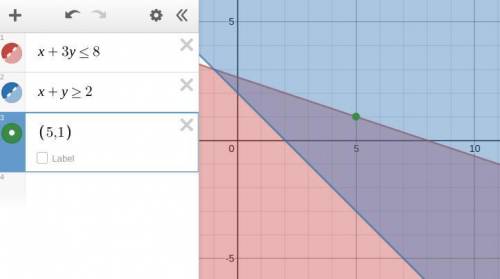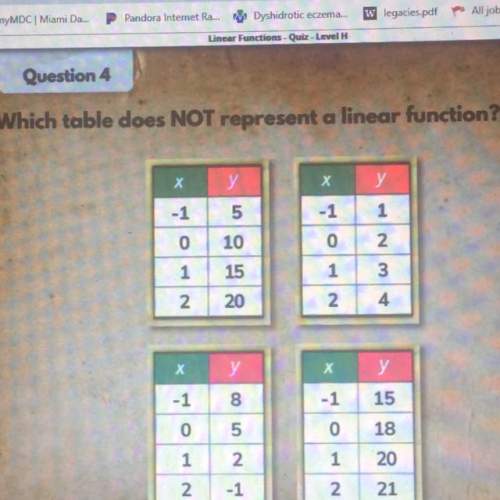
Mathematics, 14.11.2020 06:00 Aysha1311
Michelle has $8 and wants to buy a combination of dog food to feed at least two dogs at the animal shelter. A serving of dry food costs $1 and a serving of wer food costs $3. This system of inequalities models the scenario: X + 3y = 8 x + y 22 Part A: Describe the graph of the system of inequalities, including shading and the types of lines graphed. Provide a description of the solution set. (4 points) Part B: Is the point (8, 2) included in the solution area for the system? Justify your answer mathematically. (3 points) Part C: Choose a point in the solution set and interpret what it means in terms of the real-world context. (3 points)

Answers: 3
Another question on Mathematics

Mathematics, 21.06.2019 17:00
Asays "we are both knaves" and b says nothing. exercises 24–31 relate to inhabitants of an island on which there are three kinds of people: knights who always tell the truth, knaves who always lie, and spies (called normals by smullyan [sm78]) who can either lie or tell the truth. you encounter three people, a, b, and c. you know one of these people is a knight, one is a knave, and one is a spy. each of the three people knows the type of person each of other two is. for each of these situations, if possible, determine whether there is a unique solution and determine who the knave, knight, and spy are. when there is no unique solution, list all possible solutions or state that there are no solutions. 24. a says "c is the knave," b says, "a is the knight," and c says "i am the spy."
Answers: 2

Mathematics, 21.06.2019 17:00
In tossing one coin 10 times, what are your chances for tossing a head? a tail? 2. in tossing one coin 100 times, what are your chances for tossing a head? a tail? 3. in tossing one coin 200 times, what are your chances for tossing a head? a tail? deviation = ((absolute value of the difference between expected heads and observed heads) + (absolute value of the difference between expected tails and observed tails)) divided by total number of tosses. this value should always be positive. 4. what is the deviation for 10 tosses? 5. what is the deviation for the 100 tosses? 6. what is the deviation for 200 tosses? 7. how does increasing the total number of coin tosses from 10 to 100 affect the deviation? 8. how does increasing the total number of tosses from 100 to 200 affect the deviation? 9. what two important probability principles were established in this exercise? 10. the percent of occurrence is the obtained results divided by the total tosses and multiplied by 100%. toss the coins 100 times and record your results. calculate the percent occurrence for each combination. percent head-head occurrence: percent tail-tail occurrence: percent head-tail occurrence:
Answers: 3


Mathematics, 21.06.2019 23:00
Which of the following scenarios demonstrates an exponential decay
Answers: 1
You know the right answer?
Michelle has $8 and wants to buy a combination of dog food to feed at least two dogs at the animal s...
Questions

Business, 24.11.2020 14:00

History, 24.11.2020 14:00

History, 24.11.2020 14:00

Chemistry, 24.11.2020 14:00

Mathematics, 24.11.2020 14:00

Health, 24.11.2020 14:00

History, 24.11.2020 14:00

Mathematics, 24.11.2020 14:00

Social Studies, 24.11.2020 14:00

Mathematics, 24.11.2020 14:00

English, 24.11.2020 14:00




Mathematics, 24.11.2020 14:00


English, 24.11.2020 14:00

Mathematics, 24.11.2020 14:00







